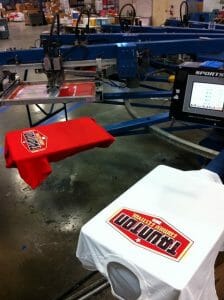In the sport of track and field, there are a few types of relay races. All at different distances. You may have seen those before on the Olympics or maybe even at your local high school.
Concrete-feet enabled kids like me didn’t participate. Too slow. I can yell loud though.
“C’ mon!”
The make or break moment for these relay teams wasn’t so much the speed of the runners, but how well they handed off the baton to the next runner for their leg of the race.
That transition matters.
A mistimed attempt, or worse, a dropped baton spelled doom for even the speediest of relay race teams.
In your shop, you face the same challenge every day if you equate how an order gets passed from one department to the next. It’s just like that baton in the relay race.
Is it a smooth and seamless handoff that propels the next leg of the race with awesome astonishing speed?
Or, it is the kind that makes everyone groan with sadness and tears of frustration?
Sadly, correcting the tears of frustration part is what I want to write about. Can you relate?
You know these challenges well, as you deal with the repercussions of those dropped batons every day. In this article, I’ll map out how that order baton gets passed from hand to hand as it makes its way around your shop.
First Lap Baton
The first lap baton is run by your customer.
That’s right.
What they are bringing to handoff to you is loaded with potential for both excellence and failure. And the next customer’s handoff will be loaded with something different.
Why?
Well, what are they handing off?
That baton is colored by the expectations they have of you. Do they see you as an artisan or craftsman capable of creating the most amazing work ever produced in the industry? Or is your shop a commodity, where the judging is all based on whittling away at your pricing down to the lowest penny?
Are they handing off correct information that you can use to prepare the quote and produce the order with lighting fast success? Is the information correct and relevant, or will there be a few rounds of changes before the final numbers click in for the “real” order?
Will they be a partner in the creative process, or make a half dozen changes to the art before handing you a completely different idea that you have to knock out by tomorrow at noon?
The crazy thing about this baton is that unless you give your customer explicit expectations and solid processes to follow early on, how you grab their baton and run with it can be problematic.
It is effective execution of what you do with the baton after you’ve taken it and made a few fleet steps around the track that matters.
Second Lap Baton
You just took the handoff.
It is still early in the process and at the quoting and order-entry stage. The Second Lap Baton is all about information and communication.
This is the most critical point in the life of the order.
Did you ask the right questions? Do you have all of the information needed to prepare a fantastic proposal that will win you the order?
If you have a website ordering process, is it a convenient and frictionless experience? How many abandoned carts do you have? That’s a clue.
As every detail is needed for all the folks down the line from your in the order relay race in your shop, will they have everything they need to be effective?
What’s missing?
For smoother transition during the next handoff, be sure that the order entry step has a thorough quality review. Use a checklist. The more robust and detailed the order, the smoother and efficient your team will be using the information entered for the order.
Missing, inaccurate, or vague information leads to baton drops.
Checklist
For better customer order interactions think about these with your shop:
- Do you have a branded checklist of things you need to process the order correctly? Spell out your expectations early. Give some tips for success. They don’t know this industry, you do.
- Are you communicating early in the process about the “what ifs”? What if they make six changes to the art? What if they add 3 smalls to the order? What if they don’t approve the art mockup in a timely fashion? Define what success looks like.
- Do you simplify things and make them easy to understand? Most people don’t know or care about our terms. “Stitch count”, “Underbase”, “Fibrillation”, “Dye Migration”, “Choke”. That industry vocabulary list is even longer. Speak plainly and be the expert.
- How are you using automation? Can you get all pertinent information for the order in an online form with mandatory fields and have that auto drop into your system? After each order ships, does the tracking number automatically gets sent to the customer so they don’t have to request it?
- Let’s say there is a problem and you dropped that baton when your customer handed it to you. Are you building out ways to prevent that from happening again?
Third Lap Baton
Order Entry to Purchasing.
Exact information is needed to be able to buy the inventory correctly for the order. That seems like a given, right?
So why then do we have so many instances where all of the information wasn’t correct early in the process and Purchasing drops the baton?
- Youth shirts weren’t purchased for the order, because they weren’t part of the conversation.
- Quantity numbers were transposed. 84 mediums were purchased, but 48 shirts were needed.
- Styles were chosen that aren’t available and on backorder.
- Goods were ordered, but they will arrive after the needed Ship Date. Ut oh.
I’m sure you have heard the sound of this baton dropping in your shop. It makes a distinctive clank. The funny thing is that the ship date for the order rarely ever moves out, even if the janky handoff is caused by the customer.
“Production can just work late. There’s no problem with that.”
Right?
Wrong!
Who is doing the purchasing for your shop? One person, or many? Is there a defined process? Are you reviewing and logging mistakes? They might now show up right away.
Start logging and running reports on inventory purchases and chargebacks. Yep. This is a money conversation. That’s a big baton to drop.
Fourth Lap Baton
Order Entry and Art.
The Sales to Art to Production workflow is the most common hang-up in any shop.
Sales lack the creative vocabulary usually to define what’s needed for the art to be created. That’s why you get ultra-lame suggestions like “Do something cool” or “It needs to be more retail-looking”.
Usually, they simply don’t know what to say.
The art staff are the cool kids in the shop. Sometimes they can overthink things. If given the opportunity, of course, they will use an additional color to “make it look better”.
They will also create art that your customer will completely hate if left to their own devices. You have to provide them with explicit direction for what the customer wants, and is willing to pay for, to align with good business decisions. For example, working on some art for over four hours for a 24 piece order could be a problem.
Production just wants things correct and completed early. Their needs are the most important, as what they do all day makes your company money. But, they often are shortchanged on their most valuable commodity, which is time. That’s why it’s crucial to get that art approved, files separated or digitized and routed to production as fast, and as correct, as you can.
This is why that Sales to Art baton is so critical. That delay causes the most frustration in Production as they are waiting.
Map out all the time that is wasted by churning out art that needs revisions or is rejected. Your shop should strive for at least 85% of the art to be approved by the client the first time you send it over. Do your shop a favor and start tracking this. Log the changes, what gets changed, who created the art, and the customer. Once you start seeing a pattern, start developing a solution to prevent that baton from dropping.
Fifth Lap Baton
Art to Production.
As we’re apparel decorators, we do many things in the shop. Screenprinting, embroidery, digital printing, dye sublimation, and even heat press work.
Your shop doesn’t ship many blank shirts, so what you put on them matters.
How and when that art gets set up and ready for the next step can have a tremendous impact on your business. Think about your shop. I’ll bet in the last week or so, at least one job was impacted by something from your creative team.
Wrong size. Misspelled words. Delays. Wrong colors. Too many colors. Files digitized incorrectly. Separations built improperly. Wrong color mode for digital. Mockups or art approval forms showing something different than the actual files Production uses.
Sure, it’s hard work. I know, I was an art director for 14 years.
However, what we’re talking about here is the craftsmanship of the file. This, of course, starts with the information from the order. If that’s correct, there’s a better chance that what the art team creates will be correct too.
Checklist
- Have an art director or someone review every order as it comes into the art department. Look for missing, vague, or challenging information and work that out with the Sales team early. “What does this mean?” is an indication that the directions given to your art staff are not explicit enough. You can do better.
- Deadlines are based on the Ship Date. Know when creative work is due. Have a no-excuses mentality.
- Know how much time something should take. There is a huge difference in the amount of time it takes to grab a business logo and get it ready as a 4″ left chest, then creating an illustration in Photoshop that will be used as the basis for a ten-color simulated process sep for the customer’s retail store. There should be good expectations on time from the Art department and also Sales on time constraints.
- Use thumbnails to quickly sketch out a few layouts and build the best one. There isn’t an “idea” button on the keyboard. You can work faster if you already have a direction and a thumbnail sketch can provide that. Plus, with picky clients you can snap a photo of that and shoot it over to the client and ask, “Hey, is this what you mean?”
Sixth Lap Baton
Receiving to Production. How is your Receiving team making it easier for your production crew to get their jobs handled?
As the inventory comes in, it absolutely needs to be counted and checked in for accuracy. Discovering at the press that the box of kelly green shirts for that event tomorrow is actually lime green, is a heart-sinking disaster.
Your client: “You are telling me this now?”
Receiving is your defense mechanism for making sure that the most basic part of the order, the garments, are 100% correct and ready to go.
Their job is to verify.
Do it. Without fail. The moment it is delivered. There is no waiting, “until I get a chance”.
It’s a Where’s Waldo game of what’s wrong every day. Receiving’s primary purpose is to find it. Because that’s not a box of shirts, that’s a box of money.
So let’s say that inventory is correct. How can Receiving pass that baton to production smoother?
Let’s start with the box. Every box that comes in needs to be identified for the order that your shop is going to print. Use a printed label. Don’t write on the box with a marker. Take that label and affix it to the upper left-hand corner of the short side of the box. This way, all of the labels will be lined up vertically if the order is a few boxes, and it makes it easier to read and identify.
Keep the inventory that is ready to go in an area that is designated for production. Segregate each order by lining things up by the last digit of the work order number. All of the jobs that end in a “3” are in the “3” row. Ones that end in “8” are in the “8” row. It’s easy. This makes finding and picking jobs a breeze.
Whether your Receiving crew stages jobs for production, or it’s your Production team, inventory should be lined up by the equipment in each department the day before the jobs are to be produced. These are staged in priority order based on your schedule. This is always handled the day before, not the day the jobs are to be run.
Seventh Lap Baton
Production to Shipping. And by Shipping, this could be using a freight carrier, your customer pick up area, a courier, or a pack-mule.
Shipping is just a generic term for how it is leaving the building.
Your Production team’s mission is to have anything that has to ship ready one business day before that Ship Date. This means that if it is due to ship on the 30th, Production nails it by the 29th.
The reason?
It gives Shipping more time to do their work. When there is a mountain of boxes to weigh, scan, and label and there is only about thirty-two minutes until the carrier backs up to the loading dock door…you may be in trouble. But when everything that has to go is ready yesterday?
Piece of cake.
Plus, if you are “shipping” to your customer pickup-area when that customer is coming by on the 30th, and the order is on the shelf on the 29th there aren’t any worries. Raise your hand if you told your customer the 30th “by the end of the day” and they showed up when you are unlocking the front door in the morning to pick up their order.
It happens.
Which is why the Production to Shipping baton handoff is an important thing to define and work on making better.
Checklist
- For your Production team. Make sure all garments are placed neatly in the box. A packing slip is printed and placed in a clear envelope. The box is taped top and bottom. Also, the box is labeled with the correct order.
- All barcodes that are on boxes if you are reusing them are either blacked out with a marker or with a blank label. Personally, I think a blank label over the barcode looks cleaner.
- The Production team brings produced orders to shipping and stages them neatly. Have lines on the floor marking where skids or boxes should go.
- Production should also get into the system and mark that the order has been produced. This way, your Shipping team can pull a report and find any job that is scheduled to ship but hasn’t been produced and start the process of making sure it’s ready. Checks and balances are a good thing.eight
Eighth Lap Baton
Your shop back to the customer. This is often a forgotten thing.
You’ve produced the job and they’ve picked it up or you shipped it. What happens next? Have you defined that?
Are you in contact with them? Do you send a follow-up survey? Are you asking them to rate or recommend you on your Google listing?
Make sure you think about this handoff.
You want them coming back for more. In fact, you need them to recommend your shop to other folks. Are you building the opportunity for that to happen?
Don’t let that customer just drop off a cliff never to be heard from again.
Spend some time and map out a sound strategy to make your shop sticky to them. Think about the lifetime value of your customers. It’s a lot more than simply whatever they just spent.
In fact, the cost of acquiring a new customer is somewhere between five and twenty-five times the cost of keeping an existing one according to the Harvard Business Review.
Whatever you do, don’t drop that baton. You just may want your past customer to hand you another one to race with.
“You have to motivate yourself with challenges. That’s how you know you are still alive.” – Jerry Seinfeld
“A self-taught man usually has a poor teacher and a worse student.” – Henny Youngman
“Don’t sweat the petty things, and don’t pet the sweaty things.” – George Carlin





